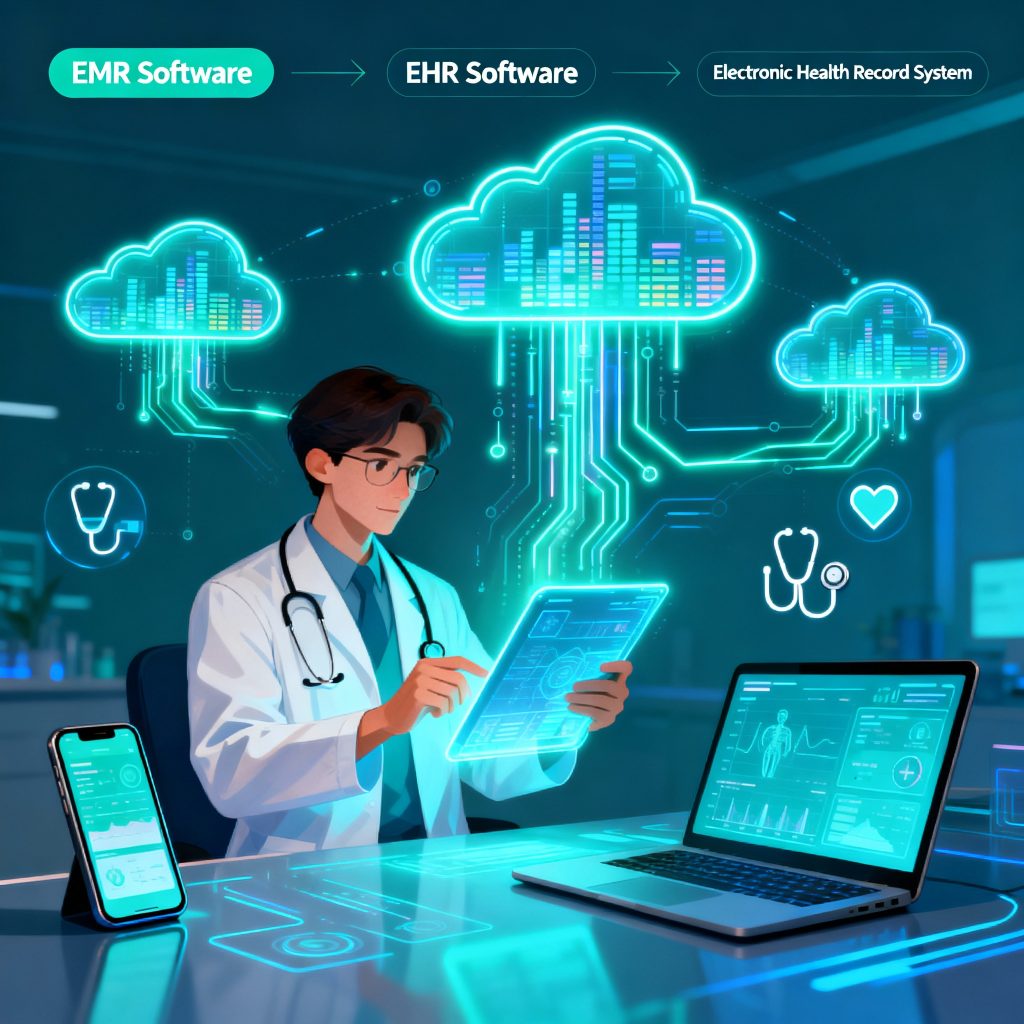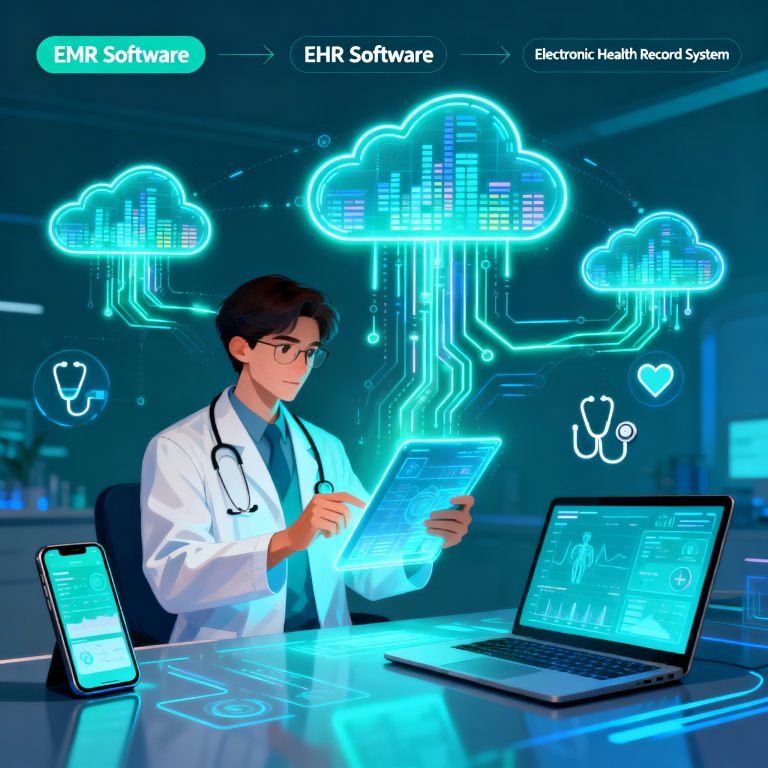The healthcare industry is entering a new digital era, where data accuracy, accessibility, and efficiency play a vital role in improving patient outcomes. As a result, EMR software, EHR software, and electronic health record systems have become essential components in transforming healthcare management. Moreover, with increasing demand for digitization, hospitals, clinics, and healthcare providers are shifting rapidly from paper-based records to advanced Electronic Medical Record Service and electronic medical records systems.
This digital transformation not only enhances patient care but also streamlines administrative workflows, reduces human errors, and improves overall healthcare delivery. Furthermore, it empowers both healthcare professionals and patients by offering secure and real-time access to essential health information.
Understanding the Evolution: From EMR to EHR
To begin with, it is crucial to understand the difference between EMR software and EHR software primarily serves as a digital version of paper charts used within a single healthcare organization. It stores information such as medical history, diagnoses, medications, and test results. However, EMR systems are limited to one facility and cannot easily share information across multiple organizations.
In contrast, EHR software (Electronic Health Record) offers a more comprehensive approach. It allows patient information to be shared securely among different healthcare providers, hospitals, laboratories, and even insurance companies. Consequently, it ensures better continuity of care, as doctors can access complete patient histories from various sources.
Therefore, while EMR software focuses on internal record-keeping, EHR software promotes interoperability and patient-centered care.
The Role of Electronic Health Record Systems
As the healthcare sector continues to evolve, electronic health record systems have become the backbone of modern medical management. They enable healthcare organizations to manage, update, and share data in real-time. Moreover, these systems eliminate the inefficiencies of manual record-keeping and ensure seamless coordination between departments.
For instance, when a patient moves from a general physician to a specialist, the doctor can instantly access all previous diagnoses and treatments through electronic medical records. As a result, there is no duplication of tests or loss of critical data. Additionally, electronic health record systems support advanced functionalities such as prescription management, billing automation, and telemedicine integration, which further improve operational efficiency.
Furthermore, by enabling secure cloud storage and mobile access, these systems empower healthcare professionals to make informed decisions anytime and anywhere.
Benefits of Electronic Medical Record Service
Implementing a reliable Electronic Medical Record Service offers countless advantages for both healthcare providers and patients. It not only saves time but also enhances accuracy and ensures data security.
Here are some key benefits:
- Improved Accessibility: Doctors and healthcare teams can access patient data remotely, even during emergencies.
- Enhanced Efficiency: Automated workflows reduce paperwork and administrative tasks.
- Better Accuracy: Digital systems minimize human errors in prescriptions and treatment plans.
- Data Security: Encrypted systems protect sensitive health information.
- Patient Engagement: Patients can access their electronic medical records through secure portals, increasing their involvement in care.
Moreover, an effective Electronic Medical Record Service simplifies compliance with healthcare regulations, ensuring transparency and accountability at every level.
Why EMR and EHR Software Are Transforming Healthcare
The transformation from traditional systems to digital platforms has revolutionized how healthcare functions. EMR software and EHR software together create a foundation for connected and patient-centric care.
For example, EHR software allows healthcare professionals to collaborate across various facilities seamlessly. Consequently, it ensures that every patient receives consistent treatment, regardless of location. Additionally, these digital tools enable faster diagnoses by providing instant access to lab results, imaging data, and previous medical records.
Moreover, healthcare organizations benefit from real-time analytics that help identify trends, predict diseases, and improve treatment strategies. Therefore, the integration of EMR software and EHR software goes beyond record-keeping—it transforms the entire care delivery ecosystem.

The Growing Importance of Electronic Medical Records
In today’s healthcare environment, electronic medical records play an increasingly important role in enhancing the quality and efficiency of care. They not only store patient data but also provide insights into patterns and long-term health trends.
Furthermore, with the rise of remote healthcare, these digital systems make telemedicine and online consultations more effective. Doctors can review medical histories instantly and make informed recommendations.
Additionally, electronic medical records help hospitals manage large patient volumes more efficiently, especially in emergencies. Consequently, healthcare facilities can offer faster and more reliable services to every patient.
The Rise of EHR Software in India
Interestingly, EHR software adoption is growing rapidly in India. Government initiatives like the Ayushman Bharat Digital Mission (ABDM) and National Digital Health Mission (NDHM) have encouraged hospitals and clinics to adopt digital health systems.
Moreover, the Indian healthcare ecosystem is moving toward interoperability, where data can flow securely between hospitals, diagnostic centers, and pharmacies. Consequently, electronic health record systems in India are helping create a unified digital healthcare infrastructure.
In addition, patients now have access to their electronic medical records, empowering them to make better health decisions and stay informed about their ongoing treatments.
Challenges in EMR and EHR Implementation
Despite their numerous benefits, adopting EMR software and EHR software is not without challenges. Many small and mid-sized healthcare providers struggle with high implementation costs, data migration, and staff training.
However, cloud-based solutions are making electronic health record systems more affordable and accessible. Moreover, healthcare software companies are now offering scalable subscription models to suit different budgets.
Another major concern involves data privacy. Therefore, implementing strong encryption, secure authentication, and regular audits is crucial. With proper planning and reliable Electronic Medical Record Service providers, these challenges can be efficiently overcome.
The Future of Electronic Health Record Systems
Looking ahead, the future of electronic health record systems appears bright and full of possibilities. As technologies like artificial intelligence (AI), machine learning, and blockchain continue to evolve, EHR systems will become even smarter and more secure.
Furthermore, the integration of wearable devices and remote monitoring tools will allow real-time health tracking, giving doctors valuable insights into patients’ conditions. Consequently, preventive care will become more data-driven and effective.
Moreover, patients will continue to play an active role in managing their health. With easy access to their electronic medical records, they can track progress, schedule appointments, and communicate with doctors directly through digital platforms.
Conclusion: Health Record Systems
In conclusion, the future of healthcare lies in innovation, integration, and information. EMR software, EHR software, and electronic health record systems are not just technologies—they are essential tools driving smarter and more connected medical management.
With reliable Electronic Medical Record Service, hospitals and clinics can achieve higher efficiency, reduce operational costs, and enhance patient satisfaction. Furthermore, as digital healthcare continues to expand, electronic medical records will remain at the core of every successful medical institution.
Ultimately, embracing these advanced solutions will lead to a healthcare system that is faster, safer, and more patient-centric—setting the foundation for a truly digital future in medicine.

